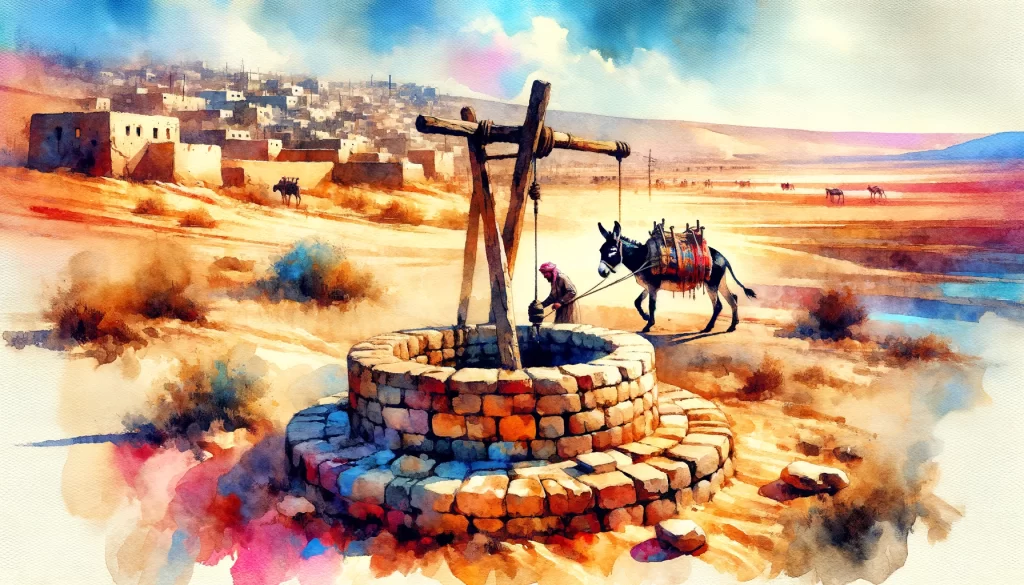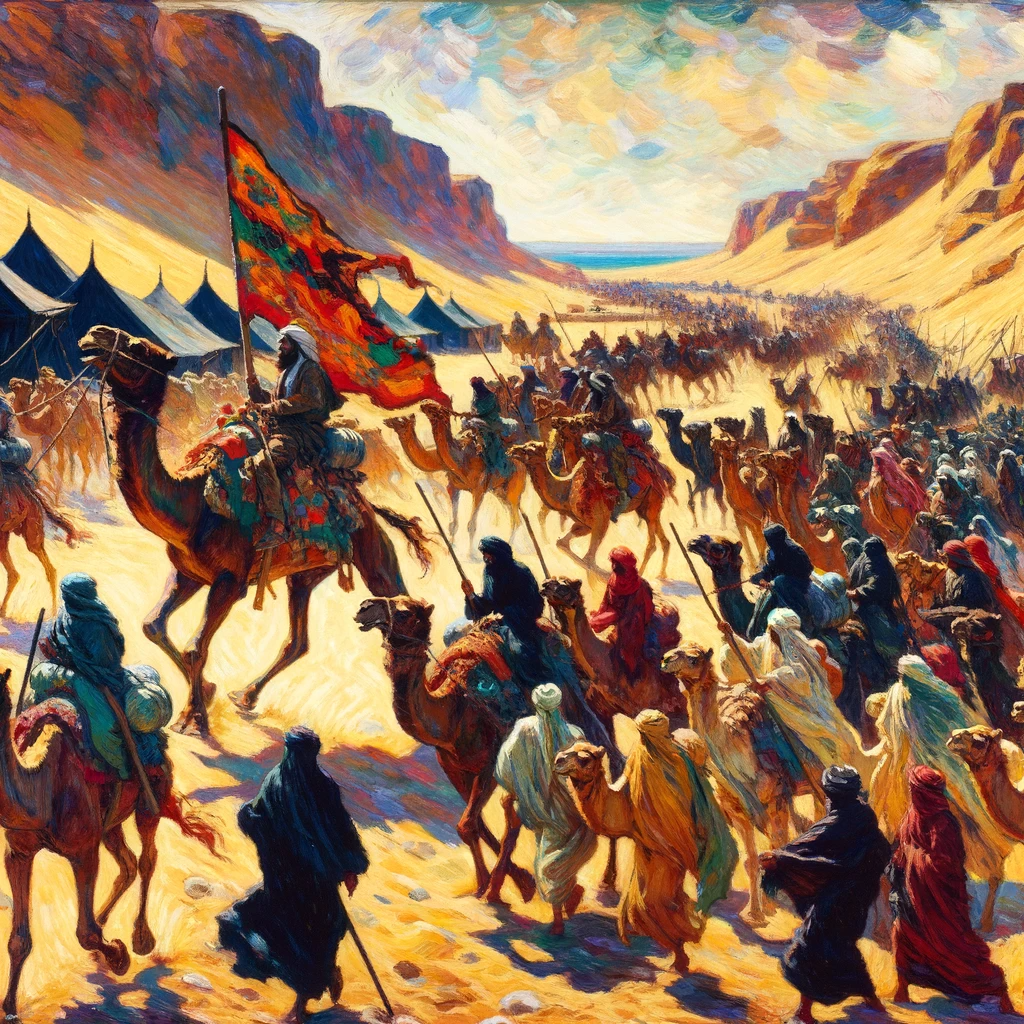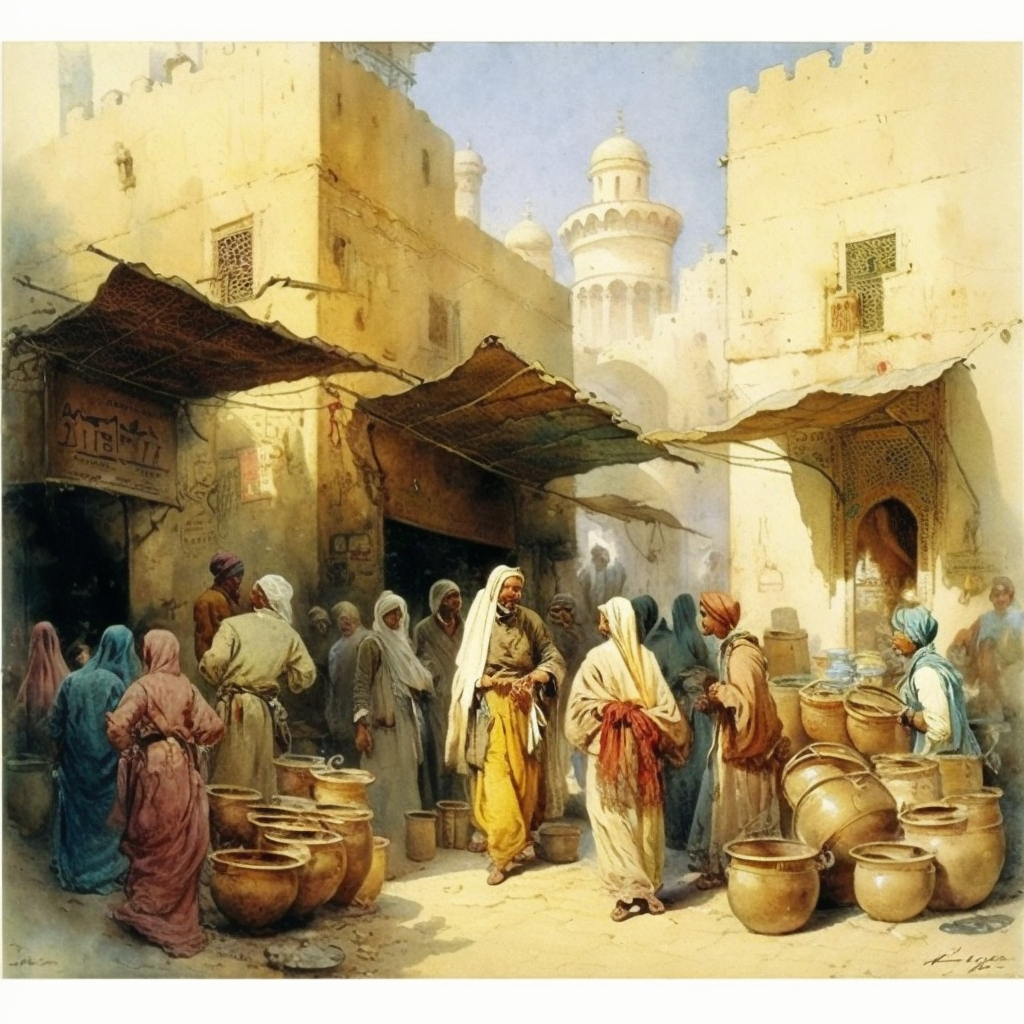In the early 20th century, Harry St. John Philby, a British explorer and writer, embarked on an extensive journey through the heart of Saudi Arabia, documenting his experiences in the seminal work “Heart of Arabia.” Philby’s narrative offers a vivid portrayal of the landscapes, architecture, and daily life in this largely uncharted territory. His encounters with key figures, including the influential leader Ibn Sa’ud, and observations of places such as Riyadh and its surrounding oasis, provide invaluable insights into the cultural and political fabric of Saudi Arabia during this period. Philby’s detailed account, characterized by its informative and descriptive style, allows readers to glimpse the historical and social dynamics of a nation on the cusp of profound transformation.
- Ibn Sa’ud is portrayed as a leader of inexhaustible energy and strategic foresight.
- Riyadh’s urban layout reflects a balance between royal authority, spiritual devotion, and community life.
- Water supply mechanisms, such as the traditional draw-wells, showcase the ingenuity of the local people in overcoming the desert’s challenges.
- The Eid praying enclosure highlights the communal and spiritual unity of Riyadh’s inhabitants.
- Cultural exchanges and personal encounters with Ibn Sa’ud reveal the nuances of social norms and hospitality.
- Military displays and leisure outings reflect the martial spirit and communal identity of the Arabian society.
The Spiritual and Architectural Fabric of the City
In “Heart of Arabia,” Philby’s observations begin with the spiritual infrastructure that underpins the city’s daily rhythm. He notes that Imam ‘Abdulrahman maintains a private chapel within his residence, highlighting the personal devotion embedded within the domestic sphere. Furthermore, Ibn Sa’ud, a figure of paramount political significance, frequents a mosque within the palace, aside from his visits to the Great Mosque for communal prayers. This practice underscores the intertwining of governance and faith in Saudi Arabia, where leaders actively participate in religious observance.
Another mosque, strategically positioned between the fort and the main thoroughfare, serves not just as a place of worship but also as a landmark within the urban landscape. Philby’s reference to the mosque’s location “alongside the fort between it and the main street” illustrates the mosque’s central role in the city’s social and architectural design.
The spiritual landscape of Riyadh is further enriched by the presence of 15-20 mosques, none of which, apart from the Great Mosque, bear any significant architectural pretensions. This observation suggests a focus on the mosques’ functional and communal roles over their aesthetic appeal. The Great Mosque stands out as an exception, indicating its special status in the religious and social hierarchy of the city.
Riyadh’s Layout
Philby’s exploration extends beyond the religious edifices to provide a panoramic view of Riyadh’s urban landscape. The palace, with its “irregular mass,” and the residences of the royal family dominate a significant portion of the city’s central area, encompassing roughly a quarter of its total expanse. This spatial arrangement signifies the central role of the ruling family in the city’s life, both geographically and politically.
Adjacent to these eminent structures, mosques and the fort collectively occupy an almost equal area. Philby’s estimation of space allocation within the city reveals a balance between the secular power of the royal family and the spiritual authority represented by the mosques. The fort’s inclusion alongside these religious and royal buildings underscores its importance in the city’s defensive and administrative functions.
The remainder of Riyadh is densely populated with ordinary dwelling houses, “thickly dotted” within the area enclosed by the city’s walls. Philby’s brief mention of these residences implies a vibrant community life, albeit without the architectural distinction of the mosques or the palace. This section of the city, while not elaborated upon, is crucial for understanding the everyday lives of its inhabitants.
“All round the city, except towards the north-east, lie the dense palm-groves of the oasis,” Philby notes, pointing to the city’s agricultural foundation and the natural bounty that sustains it. The oasis not only encircles the city, providing a lush contrast to the arid surroundings but also supports the life within through its resources.
Oasis, Agriculture, and Water Supply
Philby’s narrative further delves into the lifeblood of Riyadh and its environs—the oasis. This verdant expanse, stretching “all round the city, except towards the north-east,” is more than a mere geographic feature; it represents the city’s connection to the natural world and its primary source of sustenance. The oasis, with its dense palm-groves, is not only a refuge from the city’s hustle but also a testament to the ingenuity and resilience of its people in harnessing the desert’s scarce water resources for agriculture and habitation.
The inclusion of buildings within many palm groves signifies the oasis’s role as a place of respite. These country residences, belonging to the city’s inhabitants, underscore the oasis’s importance in providing a temporary escape from urban life. Philby’s mention of these retreats highlights the cultural practice of seeking rejuvenation and peace in the midst of nature, a tradition deeply embedded in the local lifestyle.
Water Supply Mechanisms
The oasis’s vitality is intricately linked to the sophisticated water supply mechanisms Philby describes, with draw-wells or Jalibs playing a pivotal role in the irrigation and sustenance of the area. He provides a detailed account of the Wusaita well, owned by Imam ‘Abdulrahman, as a quintessential example of these life-sustaining structures. Measuring about ten feet square at the top and tapering slightly downwards, these wells are hewn out of the solid limestone rock, demonstrating the ingenuity and engineering skills of the local populace in securing water in such an arid landscape.

Philby’s description of the well’s machinery—comprising pulleys, rollers, stout hempen ropes, and leather buckets (Qarah), often made from whole goatskins—paints a vivid picture of the manual and animal labor involved in water extraction. This process, reliant on the strength of great donkeys of the Hasa breed, exemplifies the harmonious relationship between the community, their animals, and the environment. The detailed mechanism, where donkeys descend a sharp incline to draw water, illustrates a complex yet efficient system developed over centuries to combat the desert’s harsh conditions.
“The animals, having reached the bottom of the incline, pause for a moment and turn round, each pivoting on his own centre,” Philby notes, highlighting the rhythmic, almost ritualistic nature of this task. This meticulous operation not only emphasizes the physical efforts required to sustain the oasis but also reflects the community’s deep-rooted connection to their land and resources.
Cemeteries and Community Memory
In Philby’s exploration of Riyadh, he pays particular attention to the city’s cemeteries. He describes two main cemeteries: a larger one near the Shamsiyya gate and a so-called royal cemetery situated to the east, on the left bank of the Shamsiyya torrent-bed. These burial grounds, with their “wilderness of low earthen mounds and tumbled debris,” evoke a sense of communal memory and the inevitable passage of time.
Philby’s observations highlight the egalitarian nature of death in Riyadh, where “prince and peasant lie side by side without distinction.” This aspect of the cemeteries underscores the unifying force of death in the community, where social hierarchies are levelled, and all are equal in the face of mortality. The practice of visiting graves to ask for God’s pity on the departed further illustrates the enduring connections between the living and the dead, maintaining a bridge between past and present generations.
However, Philby also notes a certain anonymity and forgetfulness that shrouds these sites over time, as “their successors will forget, and none could—or perhaps would—point out to me the last resting-places of the great Faisal and his predecessors.” This statement reflects the fleeting nature of human memory and the gradual erosion of individual legacies, emphasizing the cemeteries’ role in mediating between personal and collective histories.
The Eid Praying Enclosure
A distinctive feature of Riyadh’s spiritual and communal landscape, as noted by Philby, is the Eid praying enclosure. Situated about midway between the two cemeteries and in front of the main east gate, this large bare oblong space, enclosed by a low mud-wall, hosts the congregation for prayers only on the significant feast days of Eid. It is equipped with a Qibla niche in the middle of the western side, orienting worshippers towards Mecca during their prayers. This enclosure, Philby remarks, is “reckoned to be large enough to contain the whole male population of praying age of the city,” illustrating its central role in the religious life of the community.
Interestingly, Philby points out the gender dynamics at play during these congregational prayers, noting that women, while permitted to participate in the Eid prayers, are excluded from the enclosure itself. Instead, they pray on the open ground behind it, a practice that reflects the traditional roles and spaces allocated to men and women within the religious and social fabric of the community.
Ibn Sa’ud’s Leadership and Persona
Harry St. John Philby presents a compelling portrait of Ibn Sa’ud, a leader whose extraordinary vigour and dedication to the state’s affairs mark him as a figure of significant historical import. Philby describes Ibn Sa’ud as a man of “inexhaustible energy,” a leader who prioritizes the well-being of his state above all personal considerations. This dedication is evident in Ibn Sa’ud’s daily routine, which Philby notes is characterized by minimal sleep—approximately four hours at night and an occasional two-hour nap during the day—underscoring a life devoted to governance and the observance of religious duties.
Ibn Sa’ud’s physical presence is as commanding as his political acumen, standing at a stature “rarely attained by Arabs,” which, coupled with his choice of simple flowing robes, lends him an air of both authority and accessibility. Despite his responsibilities, Ibn Sa’ud maintains a punctilious adherence to prayer times, reflecting his deep-rooted faith. His meals, however, are described as casual and irregular, perhaps a testament to the demands placed upon him by his role as the ruler of the land.
Diplomatic Engagements and Political Strategy
Philby’s recounting of his diplomatic mission to Riyadh offers a revealing look into the political acumen of Ibn Sa’ud and the strategic considerations underpinning his leadership. Tasked by his government to discuss matters of mutual interest and report on the situation in Central Arabia, Philby found in Ibn Sa’ud a leader both willing and able to engage with the broader political dynamics of the time. The negotiations aimed to involve Ibn Sa’ud more directly in the war effort, reflecting a recognition of his potential as a pivotal ally in the region.
The objectives of Philby’s mission—cultivating friendly relations between Arab states allied with the British, efficiently prosecuting the blockade of enemy territory, and utilising the military resources of friendly Arab states—were met with a keen understanding by Ibn Sa’ud. He perceived the potential benefits of cooperation, notably the stabilisation of his own position and the securing of financial backing from the British Government, essential for the development of a country still bearing the scars of anarchy and discord.
Philby’s narrative highlights the swift pace of the diplomatic engagements, with audience after audience conducted at a dizzying speed. “Audience followed audience with bewildering rapidity,” Philby recalls, underscoring the urgency and intensity of the discussions. This period of negotiation, culminating in a private interview that put the finishing touches on the first stage of their negotiations, demonstrates Ibn Sa’ud’s direct approach to diplomacy and his eagerness to seize the moment for the benefit of his realm.
The diplomatic dialogue between Philby and Ibn Sa’ud, characterised by its depth and rapid progression, not only facilitated a mutual understanding but also set the stage for substantive cooperation. Philby’s account provides a window into the complexities of international relations in the Arabian Peninsula during a tumultuous period, showcasing Ibn Sa’ud’s strategic foresight and his ability to navigate the intersecting interests of his kingdom and those of foreign powers.
Through these engagements, Ibn Sa’ud emerges as a leader of considerable diplomatic skill, adept at balancing the internal needs of his state with the exigencies of international politics. Philby’s detailed recounting of their negotiations offers a testament to the significance of these diplomatic efforts in shaping the course of Arabian and world history during the early 20th century.
Social Dynamics and Cultural Observations
One of the more intimate glimpses into the daily life and cultural norms of Riyadh as observed by Philby involves a personal encounter with Ibn Sa’ud that revolves around the practice of smoking. Despite the stringent prohibitions against tobacco within the kingdom, Philby recounts an occasion where Ibn Sa’ud visited him shortly after a messenger had announced the leader’s impending arrival. This visit caught Philby and his companion, Colonel Cunliffe Owen, in the midst of smoking, leading to a hurried concealment of their pipes and tobacco. Ibn Sa’ud‘s subsequent entrance into a room “heavy with pungent smoke” and the lack of any overt acknowledgment of the faux pas display a nuanced understanding and tolerance, characteristics that define Ibn Sa’ud‘s interactions with foreign guests.
This incident not only illuminates the personal character of Ibn Sa’ud but also reflects broader themes of cultural exchange, hospitality, and the complexities inherent in navigating social norms differing from one’s own. Philby notes, “It was the first but by no means the last time that I was surprised almost in flagrante delicto by Ibn Sa’ud,” highlighting the recurring nature of such cultural intersections during his stay. Moreover, Ibn Sa’ud‘s discreet handling of the situation—subsequently sending in a slave with a censer to purify the air—underscores a respect for the personal habits of his guests, even when they clash with local customs.
Military Displays and Leisure Activities
Philby’s recounting of a military display and leisure outing, arranged as a formal farewell to Colonel Hamilton, stands as a vivid portrayal of the martial spirit and social customs of Riyadh. He describes a grand cavalcade, led by Ibn Sa’ud and comprising many members of his family and court, all on horseback, as they streamed out of the city towards the camping ground near the Shamsiyya garden. This procession, not merely a display of horsemanship but a celebration of communal identity and strength, reflects the deep-rooted martial traditions of the Arabian Peninsula.
The event, characterized by Philby as a “goodly cavalcade,” involved a spirited display of military prowess, with horsemen arranged into two groups for a tournament. Ibn Sa’ud, raising himself to his full height on his stirrups, initiated a war-chant, which was then taken up by the following riders, breaking into a canter and engaging in a mock battle with swords or rifles poised aloft. This scene, devoid of actual combat yet rich in symbolic gesture, captures the essence of Arabian martial culture, where the display of skill and bravery is intertwined with the social and ceremonial fabric of life.

Philby’s observation that “there was no firing, for in Arabia, as elsewhere, the discharge of firearms on such occasions is considered in bad taste” provides insight into the etiquette and values governing martial displays. The emphasis is placed on the artistry of the display and the collective expression of martial vigor, rather than on the simulation of actual combat.
Harry St. John Philby’s “Heart of Arabia” offers a meticulously detailed and vivid account of early 20th-century Saudi Arabia, marked by its exploration of the spiritual, architectural, and social fabric of Riyadh. Through his interactions with Ibn Sa’ud, Philby provides an intimate glimpse into the leadership and political strategy that shaped the kingdom during a period of significant change.
FAQ
Q: Who is Harry St. John Philby?
A: A British explorer and writer who documented his experiences in Saudi Arabia in the early 20th century.
Q: What role does Ibn Sa’ud play in the narrative?
A: He is depicted as a pivotal leader with a profound impact on the region’s political and social landscape.
Q: How is the urban layout of Riyadh described?
A: As a blend of royal residences, mosques, and community spaces that reflect the city’s complex identity.
Q: What significance does the oasis hold for Riyadh?
A: It’s vital for agriculture, providing a lush contrast to the surrounding desert and supporting the city’s life.
Q: How are water supply challenges addressed in Riyadh?
A: Through innovative draw-wells and traditional mechanisms that illustrate local ingenuity.
Q: What is the cultural importance of cemeteries in Riyadh?
A: They serve as communal spaces that underscore the transient nature of life and the importance of memory.
Q: What does the ‘Id praying enclosure represent?
A: A space for communal prayers that underscores the spiritual unity and collective identity of the city’s residents.
Q: How do cultural exchanges with Ibn Sa’ud enhance the narrative?
A: They provide insight into the social norms, hospitality, and the adaptability of Saudi society.
Q: What do military displays signify in the context of Arabian society?
A: They reflect the martial spirit, communal bonds, and the rich traditions of the Arabian Peninsula.

